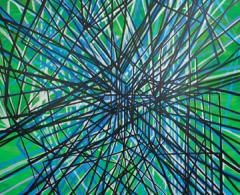
This Article From Issue
July-August 2014
Volume 102, Number 4
Page 245
DOI: 10.1511/2014.109.245
To the Editors:
I am sure that it is rare to catch Henry Petroski (“Impossible Points, Erroneous Walks,” Engineering, March–April) in an erroneous statement, but I noticed a small error in the following statement: “Among the hotly debated equine topics of the 1870s was whether at any time in its gait a trotting horse has all four feet off the ground simultaneously.”

Wikimedia Commons
The controversy was with respect to a galloping horse, not a trotting one. The debate was fueled, if not instigated, by the paintings of Frederic Schneider Remington, the famous sculptor and painter of the American west. He portrayed galloping horses in his paintings as having all four feet off the ground simultaneously. See the painting Dash for the Timber as an example (above).
The human visual system integrates stimulation over very brief time intervals, so that visual perception is somewhat like time-lapsed photography. As with nearly all human behaviors, there are marked individual differences in how long the integration interval is. Apparently, Remington and Leland Stanford had what the graduate students in my laboratory called “fast eyeballs.”
One of my research interests was to determine, similar to a movie camera, how many “frames” a second the human visual system takes. There are several methods of investigating integration times in the laboratory. One is to hone in on perception of a missing dot in a 5 x 5 matrix of dots by presenting it at varying time intervals. As an example, for a given subject a 25 millisecond exposure of the matrix may yield a report accuracy of the missing dot position of 95 to 100 percent. The matrix stimulus is then divided into random halves, one half containing the missing dot, and the halves presented successively and at timed intervals to several hundred seconds. In order for report accuracy, the two halves have to be integrated into a composite perception. Among a college population, report accuracy remains high as long as the total duration of the stimulation is on the order of 100 milliseconds. Brightness perception also shows a similar summation interval. It follows Bloch’s law: Intensity I multiplied by time t equals a constant c, which is similar to the Bunsen Roscoe law for photography. In the 1950s there was some interest in whether consciousness was quantized into psychological moments. In terms of this conception, succeeding stimuli would be summed into a composite perception if they occurred in the same psychological moment.
Testing of a small sample of professional umpires and referees showed that they tend to have very fast eyeballs. But integration increases markedly with old age. Sixty-year-olds have several times as long an integration time as twenty-year-olds. If you want to know whether you have fast eyeballs, do you see how a housefly launches itself into flight from a flat surface such as a tabletop?
Charles W. Eriksen, Emeritus
University of Illinois, Urbana–Champaign

American Scientist Comments and Discussion
To discuss our articles or comment on them, please share them and tag American Scientist on social media platforms. Here are links to our profiles on Twitter, Facebook, and LinkedIn.
If we re-share your post, we will moderate comments/discussion following our comments policy.